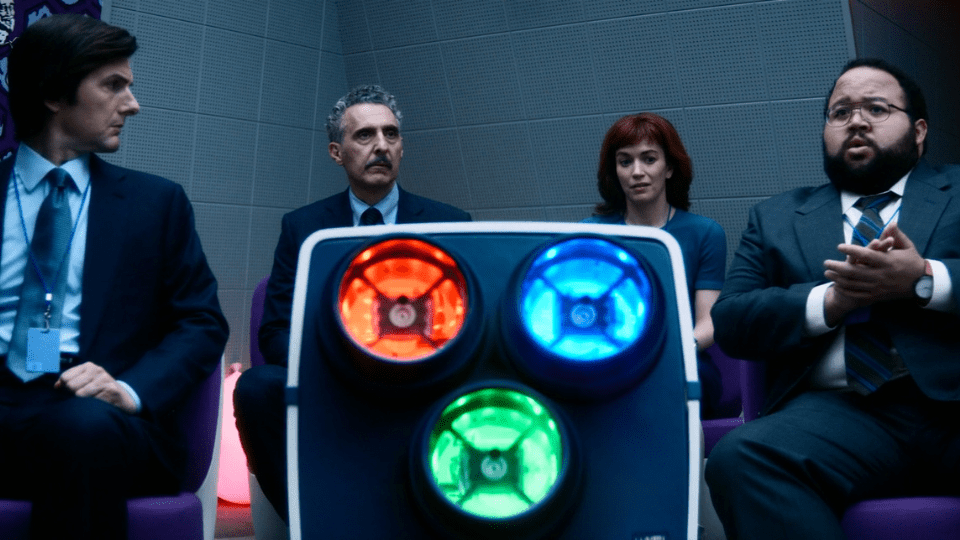The Apple TV+ series Severance has always thrived on mystery, but Season 2, Episode 4 (“Woe’s Hollow”) introduces a twist that redefines what we thought we knew.
In a pivotal moment, Mr. Milchick screams into a walkie-talkie to “remove the Glasgow Block” and with those four words, Helly R returns to consciousness after being Helena Eagan the whole series up until now. As well as being a fantastically tense scene where Irving tries to drown the future Lumon CEO to twist Milchick's hand, the revelation about the "Glasgow Block" adds a major new layer to the show’s psychological labyrinth. So we have some new and profound questions about identity, consent, and control!
For fans keeping a close eye on the technology behind Lumon Industries’ severance procedure, The Glasgow Block moment isn’t just a plot twist - it’s a seismic shift in the boundaries between Innie and Outie.
The severance process is no longer just a matter of floor access or physical geography. It’s programmable and manipulable.
What Is the Glasgow Block in Severance?
The Glasgow Block Severance protocol first appeared quietly in Season 1, Episode 8, tucked into the control room’s interface when Dylan was activating the Overtime Contingency. At the time, it was just another mysterious term in a sea of cryptic UI options. But Season 2 has made its function chillingly clear: the Glasgow Block is a digital barrier that determines which consciousness - Innie or Outie - is active, and where.
When Mr. Milchick orders the Glasgow Block removed, Helena suddenly switches into Helly R, her Innie persona. This switch is instant, violent, and disorienting especially because it happens under water! But it also confirms something vital: Lumon has far more granular control over consciousness than we realized.
The chip doesn’t just divide memory based on location, it can be toggled, like flipping a switch. And the Glasgow Block seems to be the failsafe that keeps the “wrong” self from waking up in the “wrong” place. This has massive implications! The severance process is no longer just a matter of floor access or physical geography. It’s programmable and manipulable.
Control Beyond the Severed Floor
The Glasgow Block mechanism confirms something that many fans have long suspected; Lumon’s control of its employees extends well beyond the sterile white hallways of the severed floor. We now know that Outies can remain active inside Lumon, and Innies can be awakened outside of it - if the company chooses. This opens the door to terrifying scenarios. Could an Innie be forced into service during an Outie’s supposed leisure time? Could an Outie be sent to spy or sabotage, then erased again before returning home? The possibility that consciousness is no longer location-locked but permission-locked introduces moral hazards the show hasn’t even fully explored yet.
It also reframes everything we’ve seen before. Was Helly R always Helena in disguise? How many times have other characters unknowingly swapped selves without realizing it? Could the MDR team’s hallucinations or moments of déjà vu be the result of the Glasgow Block flickering - intentionally or accidentally?
Could the MDR team’s hallucinations or moments of déjà vu be the result of the Glasgow Block flickering - intentionally or accidentally?
The Glasgow Block isn’t just a piece of sci-fi tech, it’s a symbol of Lumon’s desire for total control. It asks whether any part of the human self is truly safe from being co-opted by a system that sees identity as a toggle, not a truth.
Rewriting the Rules of Severance
If Severance Season 1 introduced us to the horrifying concept of splitting the self in two, then Season 2 is showing us that this division is not fixed, it’s fluid. The Glasgow Block event proves that the boundaries of identity can be rewritten in real time, by people with the right access codes and a casual attitude toward ethics. This reframing of the severance process turns earlier scenes on their heads.
Suddenly, the ability to trigger Dylan's Innie from home isn’t a freak glitch or panicked one off, it’s a preview of the true potential (and danger) of Lumon’s technology.
Even the cryptic “Overtime Contingency” makes more sense now: it’s not just a surveillance measure. It’s a method for puppeteering entire personalities, remotely. More than just a sci-fi gadget, the Glasgow Block is an ideological horror. It implies that the severance procedure was never about creating a better work-life balance. It’s about control of behavior, of memory, of identity itself.
The Glasgow Block Severance revelation is a game-changer. It reveals that the split between Outie and Innie isn’t about walls or elevators, it’s about code. And that means any character, at any moment, might not be who we think they are. As Severance continues to dig deeper into corporate overreach, digital consciousness, and psychological autonomy, the Glasgow Block will almost certainly remain central to the unfolding mystery. Whether it’s a tool of liberation or oppression depends on who holds the remote.














